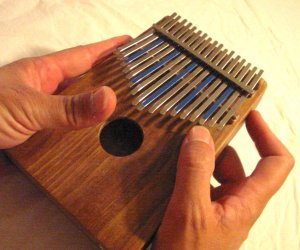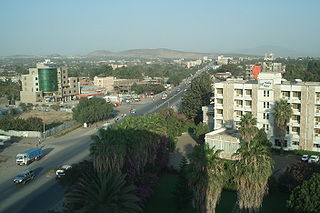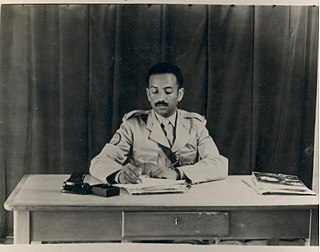Related Research Articles

Addis Ababa, also known as Finfinne, is the capital and largest city of Ethiopia. According to the 2007 census, the city's population is estimated at 2,739,551 inhabitants. Addis Ababa is a chartered city, and is also the capital of Oromia.

Mbira are a family of musical instruments, traditional to the Shona people of Zimbabwe. They consist of a wooden board with attached staggered metal tines, played by holding the instrument in the hands and plucking the tines with the thumbs, the right forefinger, and sometimes the left forefinger. Musicologists classify it as a lamellaphone, part of the plucked idiophone family of musical instruments. In Eastern and Southern Africa, there are many kinds of mbira, often accompanied by the hosho, a percussion instrument. It is often an important instrument played at religious ceremonies, weddings, and other social gatherings. The "Art of crafting and playing Mbira/Sansi, the finger-plucking traditional musical instrument in Malawi and Zimbabwe" was added to the UNESCO Representative List of the Intangible Cultural Heritage of Humanity in 2020.
Ethiopian music is a term that can mean any music of Ethiopian origin, however, often it is applied to a genre, a distinct modal system that is pentatonic, with characteristically long intervals between some notes.

Oromia is a regional state in Ethiopia and the homeland of the Oromo people. The capital city of the State of Oromia is Addis Ababa, also known as Finfinne. Currently the state consists of 21 administrative zones.

A lamellophone is a member of the family of musical instruments that makes its sound by a thin vibrating plate called a lamella or tongue, which is fixed at one end and has the other end free. When the musician depresses the free end of a plate with a finger or fingernail, and then allows the finger to slip off, the released plate vibrates. An instrument may have a single tongue or a series of multiple tongues.

Adama , officially known as Adaamaa and formerly Nazreth, is a city in central Oromia Region, Ethiopia. Adama forms a Special Zone of Oromia and is surrounded by East Shewa Zone. It is located at 8.54°N 39.27°E at an elevation of 1712 meters, 99 km southeast of Ethiopian capital, Addis Ababa. The city sits between the base of an escarpment to the west, and the Great Rift Valley to the east.

Mulatu Astatke is an Ethiopian musician and arranger considered as the father of Ethio-jazz.
Sidama or Sidaamu Afoo is an Afro-Asiatic language, belonging to the Highland East Cushitic branch of the Cushitic family. It is spoken in parts of southern Ethiopia by the Sidama people, particularly in the densely populated Sidama National Regional State (SNRS). Sidaamu Afoo is the ethnic autonym for the language, while Sidaminya is its name in Amharic. Although it is not known to have any specific dialects, it shares over 64% lexical similarity with Alaba-K'abeena, 62% with Kambaata, and 53% with Hadiyya, all of which are other languages spoken in southwestern Ethiopia. The word order is typically SOV. Sidaama has over 100,000 L2 speakers. The literacy rate for L1 speakers is 1%-5%, while for L2 speakers it is 20%. In terms of its writing, Sidaama used an Ethiopic script up until 1993, from which point forward it has used a Latin script.

The Dorze are part of one of the Gamo village living small group in the Gamo highlands.They are native Gamo's
Orchestra Ethiopia was an Ethiopian concert band formed in 1963 by the Egyptian-born American composer and ethnomusicologist Halim El-Dabh. The group, which was founded in Addis Ababa, comprised up to 30 traditional instrumentalists, vocalists, and dancers from many different Ethiopian regions and ethnic groups. It was the first ensemble of its type, as these diverse instruments and ethnic groups previously had never played together. For a time, due to El-Dabh's efforts, the Orchestra was in residence at the Creative Arts Centre of Haile Selassie I University.
Cynthia Tse Kimberlin is an American ethnomusicologist. She is the executive director and publisher of the Music Research Institute and MRI Press, based in Point Richmond, California. Her primary area of expertise is the music of Africa, in particular Ethiopia and Eritrea.

Abatte Barihun is an Israeli jazz saxophonist and composer. His sound is reminiscent of John Coltrane's, who has highly influenced Barihun.
Tsedenia Gebremarkos is an Ethiopian singer and songwriter. Referenced in popular culture, Tsedenia received Kora Award for the 2004 single "Ewedhalehu" and led her to global interconnection with prominent singers. She is known for pop genre while also performing Ethiopian music and predominantly sings in English and Amharic languages.

Ethiopia–Israel relations are foreign relations between Ethiopia and Israel. Both countries re-established diplomatic relations in 1992. Ethiopia has an embassy in Tel Aviv; the ambassador is also accredited to the Holy See, Greece and Cyprus. Israel has an embassy in Addis Ababa; the ambassador is also accredited to Rwanda and Burundi. Israel has been one of Ethiopia's most reliable suppliers of military assistance, supporting different Ethiopian governments during the Eritrean War of Independence.
Walias Band were an Ethiopian jazz and funk band active from the early 1970s until the early 1990s. Formed by members of the Venus Band, Walias backed up many prominent singers with a hard polyrhythmic funk sound influenced by western artists like King Curtis, Junior Walker and Maceo Parker. In 1977 they recorded one of the few albums of Ethiopian instrumental music in collaboration with vibraphonist Mulatu Astatke, whose role as a bandleader and composer was also a major influence on Ethiopian popular music.

The Oromia Special Zone Surrounding Finfinne is a zone in Oromia Region of Ethiopia that surrounds Addis Ababa. It was created in 2008 from parts of North Shewa Zone, East Shewa Zone, Southwest Shewa zone and West Shewa Zones. The zone was created to support the cooperation and development of the surrounding areas of Addis Ababa, and to control the urban sprawl of this city on the lands of Oromia. The administrative center of this zone is in Addis Ababa(Finfinne). the districts and town in this zone include Akaki, Bereh, Burayu, Dubra, Holeta Town, Koye Feche, Mulo, Sebeta Hawas, Sebeta Town, Sendafa Town, Sululta, Walmara, Laga Xafo Laga Dadhi, Galaan, Sebeta Hawas (Town) and Dukem.

Gibreab Teferi Dasta, also spelled Gebreab Teferi, was an Ethiopian activist, poet and playwright known for his extensive knowledge of the Ge’ez and Amharic language.

Hailu Mergia & His Classical Instrument, also known as Shemonmuanaye, is a 1985 studio album by Ethiopian jazz musician Hailu Mergia, formerly of the Walias Band. After the band split up in 1983, Mergia moved to the United States and began studying music at Howard University, during which time he discovered an accordion and began playing it. Initially intending to record a cassette of himself playing the accordion in a small studio belonging to an acquaintance at Howard, he also incorporated other instruments in the studio, such as a Rhodes piano and synthesiser.

Jano Band is an Ethiopian rock band formed by its entrepreneurs Ermyas Amelga and former manager Addis Gessesse in 2011. It versatilely mixes progressive rock with Ethiopian music. The band includes two female back and lead vocalists, two lead male vocalists, and four musicians who play bass guitar, rhythm guitar, drum, and keyboards.
Music and politics in Ethiopia have been closely intertwined throughout Ethiopia's history.
References
- 1 2 3 Bishop, Sarah (2016). For the Motherland (#### ###): Traditional Music Performance and Nationalism in Addis Ababa, Ethiopia (Thesis). Florida State University College of Music. p. 20.
Abstract with full title ‘For the Motherland (ለእናት ሀገር): Traditional Music Performance and Nationalism in Addis Ababa, Ethiopia’
- 1 2 3 "Songs from Ethiopia and South Sudan". sbmusicology.com.